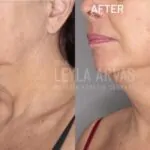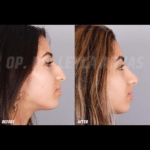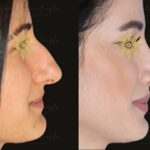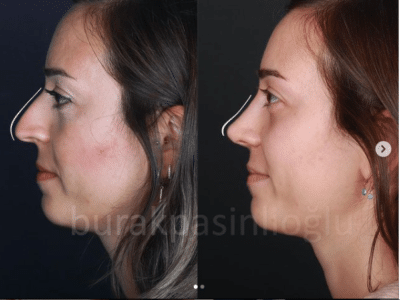 There are a lot of legends and not scientifically confirmed facts about Rhinoplasty, also known as Nose Job. Lots of people who are not experts on this subject express their opinion here and there. Meanwhile, people who really want to have an aesthetic nose job and start doing their research are confused. Many of them give up on surgery, fearing experiencing disappointment and pain, based on what they read, before they even reach the stage of meeting with the plastic surgeon.
There are a lot of legends and not scientifically confirmed facts about Rhinoplasty, also known as Nose Job. Lots of people who are not experts on this subject express their opinion here and there. Meanwhile, people who really want to have an aesthetic nose job and start doing their research are confused. Many of them give up on surgery, fearing experiencing disappointment and pain, based on what they read, before they even reach the stage of meeting with the plastic surgeon.
Every time you look in the mirror, you become unhappy with your current look and may start to experience self-confidence problems over time. This also brings plenty of psychological disorders. Let’s talk in detail about all these existing urban legends one by one, so that everything about nose aesthetics can be clarified. Let not the minds get confused more and let not the people who are unhappy with their nose being left without any solution!
Swelling and Bruising After Rhinoplasty
FALSE: Swelling and bruising on the face after rhinoplasty lasts for weeks.
TRUE: Swelling and bruising occur due to the fracture of the nasal bone during rhinoplasty; However, by using the tunnel or canal technique, these swelling and bruises are minimized. In addition, thanks to the ice applications made at regular intervals after the surgery, the healing of swelling and bruises is much faster.
As a result, the information that swelling and bruising on the face lasts for weeks is completely false. After the operations performed by experienced aesthetic and plastic surgery specialists, with the application of the right treatment, the swelling and bruises are reduced by half within 7 days, and at the latest by 3d week.
Breathing After Rhinoplasty
FALSE: Even if the desired nose look is achieved after rhinoplasty, there is no improvement in breathing.
TRUE: Rhinoplasty surgeries are not just for having an aesthetic nose. With these operations, it is also important to have a healthy nose. If the focus is on aesthetics and the curvature of the septum or other conditions that affect breathing in the nose before the operation, a solution to the problem that causes nasal congestion will not be produced with the operation. Therefore, difficulty in breathing may continue.
An experienced plastic surgeon pays attention to all the details during the examination and creates a remarkable difference in the breathing of the patient thanks to the careful interventions he applies to the septum cartilage and the reduction processes he applies to the nasal concha.
Pain After Rhinoplasty
FALSE: There is a lot of pain after rhinoplasty.
TRUE: With the development of technology, there are many positive changes in the aesthetics industry. One of these developments is that nose surgeries are no longer as painful as they used to be. After the surgery, there is only a slight pain in the form of tingling and is easily relieved with painkillers. After approximately one week after the operation, the feeling of discomfort of the person is completely removed with the removal of the tampon, splint and plaster worn during the operation.
Silicone Pads in Rhinoplasty
FALSE: Stuffs placed in the nose after the surgery are very painful.
TRUE: In today’s rhinoplasty surgeries, gauze pads that aim to stop bleeding by creating pressure are not used as in the past. Instead, airy silicone pads made of special materials are used to relax the nose and prevent adhesions that may occur in the nose after surgery. During the time the tampons are in the nose, the patient breathes easily and does not feel any pain, thanks to the holes in the tampon. They are easily and painlessly removed from the nose and do not have the possibility of sticking like gauze. Within a week after the operation, the patient is relieved even more by removing the tampon, plaster cast and sutures.
Bruises Around Eyes After Rhinoplasty
FALSE: After the surgery, there are bruises around the eyes that last for a long time.
TRUE: Sometimes in rhinoplasty operations, it may be necessary to file the bone at the junction of the nasal bone with the face in order to narrow the base of the nose. However, this situation does not cause a bruising that does not go away for a long time, as mentioned, but only a slight bruising that goes away in a few days. In this process, healing is accelerated with ice compresses and Arnica creams that reduce bruising, which should be regularly applied to the face.
Everyone Suitable For Nosejob
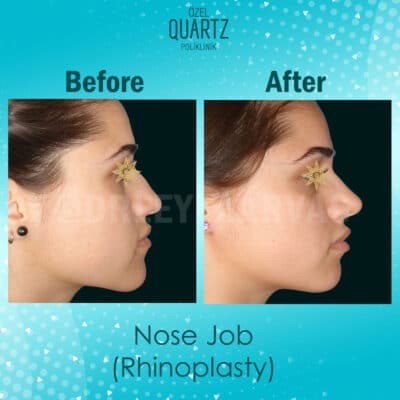
FALSE: Everyone can have the nose they want with nose surgery.
TRUE: Some patients go to the doctor with a photo of their friend or a favorite celebrity and ask the doctor to make the same nose; however, each face, nose and bone structure is unique and individual. Rhinoplasty surgeries are also very detailed and specifically designed and planned for each patient. Otherwise, making a nose that is not suitable for the face shape and bone structure will cause an unnatural appearance, and as a result, the patient will be dissatisfied after the surgery. An experienced plastic surgeon, who loves his job, will always suggest a natural looking nose, suitable for the patient’s face and bone structure, instead of making the nose desired by the patient.
Age in Rhinoplasty
FALSE: It is not necessary to be over the age of 18 to have rhinoplasty surgery.
TRUE: As in all aesthetic surgeries, the patient must have completed his/her physical and mental development in order to be an ideal candidate for rhinoplasty surgery. Otherwise, there may be a possibility of regretting the operation because the patient’s bone and cartilage tissue development is not completed before the age of 18 and the patient’s ideas about what he wants may change in the future. If there is a condition that only affects breathing, then the operation can be performed exceptionally.
Rhinoplasty Painful
FALSE: Nose surgery is very painful.
TRUE: Since the patient is under general anesthesia during the surgery, he or she does not feel any pain. After the surgery, the patient can easily get through this process with regular ice applications and mild painkillers.
Rhinoplasty Looks Natural
FALSE: The nose after rhinoplasty looks upturned and unnatural.
TRUE: Experienced plastic surgeons take care to make the most natural nose by paying attention to many details from the nostrils to the face shape of the patient. The purpose of these surgeries is not to have a small and upturned nose, but to have a nose that can breathe naturally and healthily. For this, the nasal cartilages are changed during the surgery, the arched noses are filed within the possible limits, the low nasal tips are lifted in a way that does not disturb the naturalness, and the nostrils are reduced so that they do not exceed the inner border of the eye of the patient.
Rhinoplasty Season
FALSE: Nose aesthetic surgeries cannot be performed in summer.
TRUE: As with other plastic surgeries, rhinoplasty can be performed in summer. There are only points that need attention. In order for these surgeries to be performed in the summer, the person should not wash the head area until the splint and plaster are removed, take care not to use sunglasses, not plan to go on vacation in a short time and enter the sea or pool, and should not have pollen allergies that increase in the summer months. Patients who meet these conditions can also have surgery in the summer months without any consequences.
Rhinoplasty Scars
FALSE: No scars remain after nose surgery.
TRUE: Whether or not the scar remains after nose surgeries varies depending on the method of the surgery. (Closed or open rhinoplasty) Since there will be an incision scar in patients who have an open nose surgery, it cannot be said that there will be no scar at all. However, even if a slight scar remains, this light scar that remains within a few months after the surgery will begin to fade and approach the natural color of the skin. Therefore, it becomes less and less noticeable and does not appear at all after about a year.
Sensitivity After Rhinoplasty
FALSE: After rhinoplasty, the nose becomes very sensitive.
TRUE: It is true that the nose will become more sensitive during the healing process but this is not permanent. When the healing in the tissues is completed, the sensations in the nose also return to normal.
Understand Rhinoplasty
FALSE: Rhinoplasty is easily noticed at first.
TRUE: If there is a very clear difference between the current nose and the post-operative nose, for example, if an arched nose is filed and the existing arch is completely removed, those who know the person before will know the difference because they know the old state however, if this operation was performed by a specialist, taking care for patient’s natural look, those who just know the person or see cannot understand that the nose job has been done.
Rhinoplasty with Laser
FALSE: Rhinoplasty can be also performed with a Laser.
TRUE: Laser devices work on the principle of damaging by laser beam to tissues. They never have a function such as shaping bone or cartilage tissue. In rhinoplasty, the nasal bone and tissues are intervened. This intervention is unlikely to be done with a laser. It is only used to reduce scars by peeling, although very rarely, in patients with obvious incision scars. Although in the past, the reduction of the meat in the nose was done with laser, nowadays these processes are done by radiofrequency instead of laser.
FALSE: Nose job cannot be performed after a certain age.
TRUE: There is no upper age limit for rhinoplasty surgeries. If the person’s health condition is suitable for anesthesia, the operation can be easily performed. The expectation of older people from nose surgery is generally to breathe comfortably. In this way, people who do not have aesthetic expectations can prevent difficulty in breathing by interfering with the nose wings and lifting the tip of the nose.
FALSE: The same technique is applied in all rhinoplasty surgeries.
TRUE: Rhinoplasty surgeries are operations that are performed in different techniques which completely depend on the anatomical characteristics of the person and many details are taken into consideration. Therefore, it is not possible to apply the same technique to everyone. Differences in cartilage, bone, skin, facial symmetry and subcutaneous tissue thickness bring along the necessity of applying different techniques.
FALSE: The nose tip of patients who have rhinoplasty drops after a while.
TRUE: If it is done by an experienced plastic surgeon, there is no possibility of the tip of the nose falling. The anterior part of the nose is supported by cartilages during surgery, making it resistant to falls that may occur over time.
FALSE: Rhinoplasty is quite simple and there is no point to be worried before the operation.
TRUE: Although the healing process has improved with the developing technology, rhinoplasty surgeries are performed under general anesthesia like other surgeries. For this reason, there are points that the patient should pay attention to before the operation. Before the surgery, tests and checkups related to anesthesia should be done, patient should take care care should be taken not to get flu-cold, blood thinners should be stopped as of the date recommended by the doctor, herbal medicines and herbal teas should be stopped 10 days before the surgery, and smoking should be avoided as it slows the healing process and makes breathing difficult. Consumption should be stopped at least a month before.


